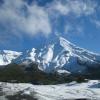Dear CHeresources Users
Could anyone explain to me the following problem:
Basing on Vendor's offer for safety valve I'm trying to verify the calculations for discharge piping.
This is due to Customer suggestion that no balanced bellows is required (costs).
My calculations show that the backpressure exceeds 10% of set pressure -> balanced bellows required.
To simplify the problem I made a simulation of real safety valve (Vendor's offer) together with pressure drop calculation in discharge piping. This is done for 1m long discharge pipe which diameter is equal to safety valve outlet -> just to check what happens if I have only short pipe without any additional pressure drop sources like elbows, expanders, etc.
The simulation shows that:
- flow in such pipe is critical.
- backpressure less than 10% of set pressure (I adjusted pipe lenght)
- the pressure at outlet is higher than atmospheric even I specify atmospheric at the outlet.
My simulation software calculates flow through the system knowing he following:
- valve data (coefficient of discharge, flowing area);
- pipe geometry (friction losses);
- fixed pressure at inlet (relieving pressure);
- fixed pressure at discharge pipe outlet (atmospheric).
Are my results reasonable or maybe there is something wrong with them?
Previously I was using real piping geometry (designed by piping department) as short as possible but quite longer, with two elbows and pipe enlargement. The flow was subcritical (through pipe) but backpressure was higher.
Now, the Customer tries to convice me that my calculation is wrong because it requires balanced bellows which cost too much (there are several identical valves).
My explanation that safety goes first seems to mean nothing to them. Have you ever faced such situation??
At the end once again my question: is my flowsheet for with reduced piping (attached) reasonable or not.
I'm trying to verify that the simulation software does its work right or maybe there is some mistake in it.
Thanks in advance for replies.
Attached Files
Edited by wojtar, 03 December 2013 - 09:13 AM.

 FB
FB














